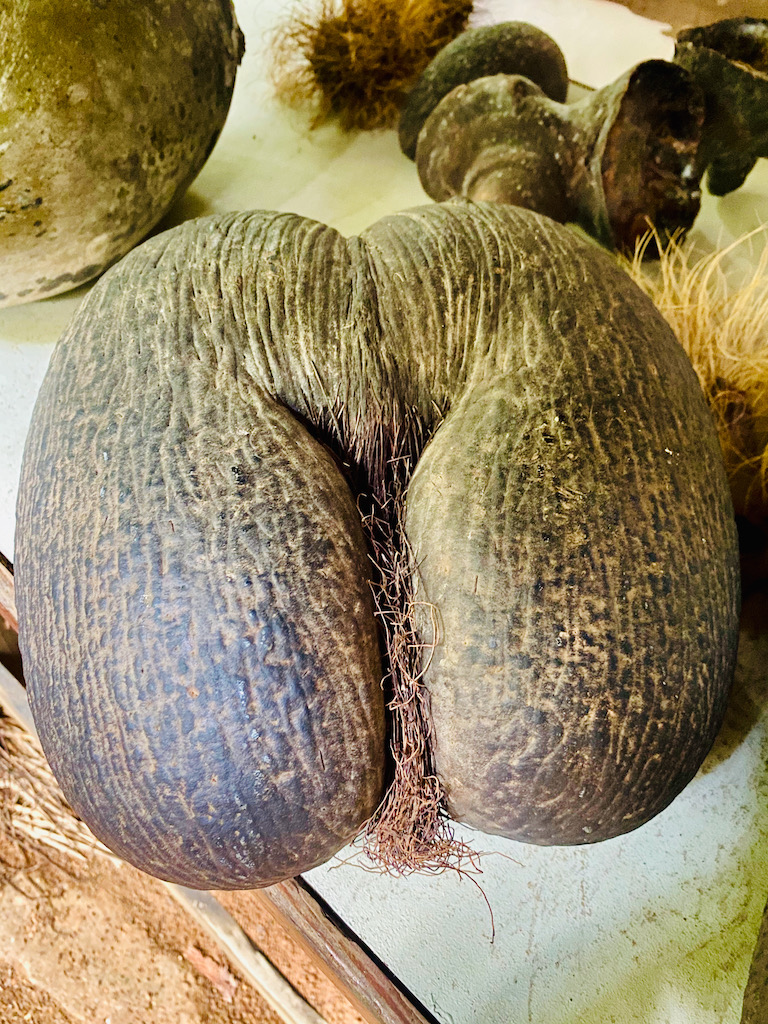

Vallée de Mai is a breathtaking forest! When discovered by explorers, it was described as the authentic Garden of Eden. I immediately understood the reason for this comparison as soon as I passed the nature reserve entrance. Nature is lush. The trees are huge and millennia-old. The plants have giant, shiny, bright green leaves — a bit like a child’s drawing where the colors are often exaggerated and too vivid.
I truly loved walking the paths of this mysterious forest in the middle of which I felt tiny.
The Nature Reserve


There are several trails available for the visit. I loved this magical place so much that we walked through all of them.
The tour times shown on the map for each loop are reliable if one takes the time to look for the endemic animals.
There are also guides at the park entrance but we decided to do the tour by ourselves. We were warned that with untrained eyes, we would not be able to spot any animal. Undoubtedly they were right, I did not see a single one!
This magnificent forest received national protection for the first time in 1966 when it was declared a nature reserve by the government and was afterward listed as a UNESCO World Heritage Site in 1983. In 1989, the management of the estate was awarded to the Seychelles Islands Foundation (SIF).
It is thanks to this organization that the forest regained its past beauty. Foreign plants and animals introduced by settlers have been eradicated, and deforestation has stopped.
Aside from the paths that run through it, it is as sublime as when first discovered.
A unique forest
This singularity is mainly due to the famous coco de mer palm trees, the iconic endemic trees whose very particular fruit shape much was written about. Its fauna is also unique. There are rare birds such as the Seychelles black parrot and the Seychelles Bulbul.




Coco de mer palm trees


The first peculiarity of these trees is that they can be classified as male or female. The male ones have “flowers” that resemble long phallic-looking catkins whereas the female ones carry the fruit.
This fruit, the sea coconut, is the largest seed in the plant kingdom and has a shape all its own. One side looks like a woman’s buttocks, and the other represents her belly and her thighs. One of its archaic botanical names is moreover, “Lodoicea callipyge Comm. ex J. St.-Hil.” with “callipyge” derived from the Greek meaning “beautiful rump.”






This appearance was reason enough to have this nut considered by many to be a rare and fascinating object with mythological, magical, and healing properties.




The coco de mer shell




At the base of the tree is a very complex cup pierced with many holes. This cavity houses the tree, its roots passing through the holes to go and plant themselves in the ground. This allows the coco de mer palm some flexibility during windy weather, the trunk not being flexible, like that of other coconut palms.
Why its name, coco de mer.
Unlike other coconuts which naturally disperse by floating and germinate when they find land, the coco de mer which can weigh up to 18 kg sinks when falling into the sea. After a long time being submerged, the shell falls, the interior decomposes and turns into gas, which causes the nut to rise to the surface. It is no longer fertile but can then float and is carried away by currents.
This is how it found itself on the Maldives coast one day. At that time, Seychelles did not yet exist. The inhabitants of the Maldives, unfamiliar with this strange fruit which did not germinate, deduced that it came from the sea. Hence its name, coco de mer. It is also found under the name “coco of Maldives.”
A legend also says that Malaysian sailors, having seen coconuts come to the surface, believed that they came from underwater trees and that there was a forest in the Indian Ocean.
The coco de mer fascinates!
After the settlement of Seychelles, other legends appeared when the male and female coconut palms were discovered. Due to the unusual erotic shapes of the catkins and the fruit, some people believed that trees made passionate love on stormy nights — male trees uprooting and approaching female trees. But beware, the trees that make love are somewhat shy, and legend has it that anyone who sees the trees mating will die or become blind.
The coco de mer is a much celebrated emblem of the country; it is even present on the country’s stamp and the visa stamp of entry.
The forest in pictures












Final point
This visit remains to be one of the most memorable moments of my stay in Seychelles. The beauty of the jungle, its tranquility only broken by the song of the birds, the trees and plants which give the impression of closing in on us, was just pure magic.
I loved discovering the majestic coco de mer and the legends inspired by it. As soon as you land in Seychelles, the very equivocal representation of this fruit is everywhere. Suffice to say that my curiosity about this shape was satisfied as quickly as it was aroused!
It is a walk one should include in their vacation without any hesitation. No description or photo can replicate the feeling of being amid these hundred-year-old giants.


